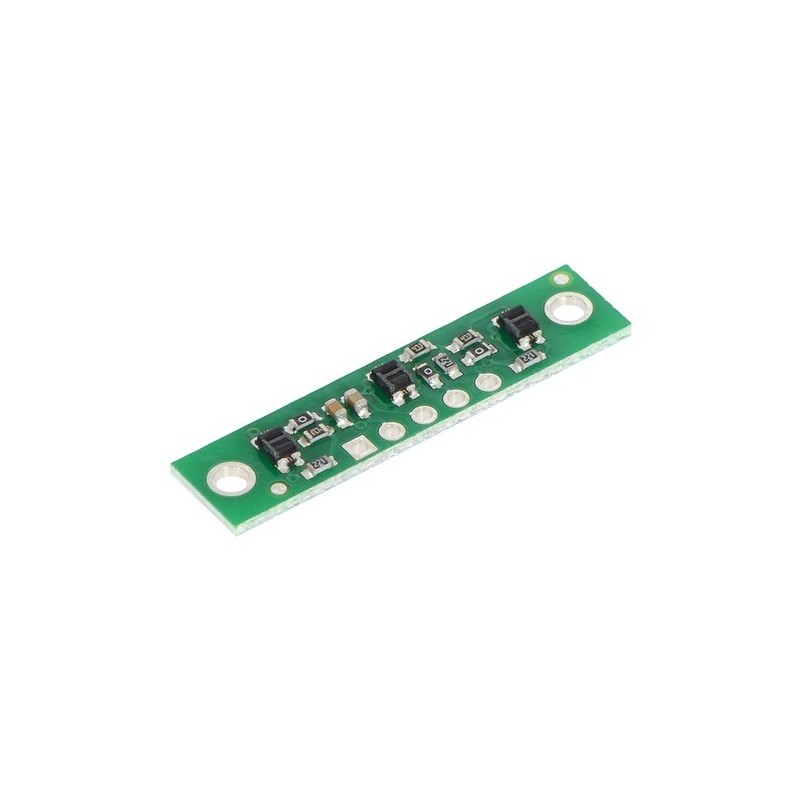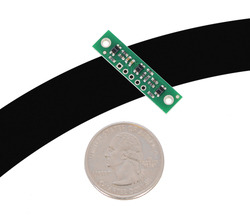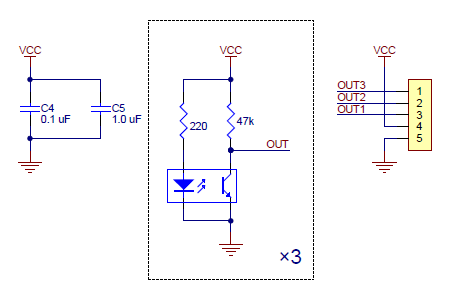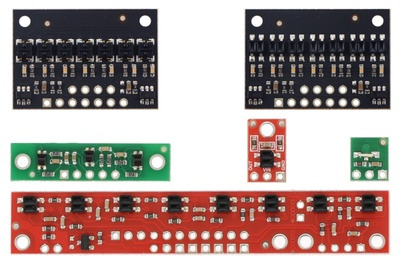

QTR-3A Reflectance Sensor Array
This compact module packs three IR LED/phototransistor pairs onto a 1.25" A— 0.3" board. The sensors are mounted on a 0.375" pitch, making this array a great minimal sensing solution for a line-following robot. Each sensor provides a separate analog voltage output.
The QTR-3A reflectance sensor array requires analog inputs to take readings. The similar QTR-3RC reflectance sensor array is available with digital I/O-compatible outputs.
 |
The QTR-3A reflectance sensor array is intended as a line sensor, but it can be used as a general-purpose proximity or reflectance sensor. The module is a convenient carrier for three IR emitter and receiver (phototransistor) pairs. With sensors spaced at intervals of 0.375" (9.525 mm) along of the board’s longer axis, this array works well as a minimal detector for line-following robots, as line-following courses are commonly made using 3/4" (19 mm) black electrical tape. The middle sensor is slightly offset along the short axis of the board.
Each phototransistor is connected to a pull-up resistor to form a voltage divider that produces an analog voltage output between 0 V and VCC (which is typically 5 V) as a function of the reflected IR. Lower output voltage is an indication of greater reflection.
The LED current-limiting resistors are set to deliver approximately 17 mA to the LEDs when VCC is 5 V, making the total board consumption just over 50 mA. The schematic diagram of the module is shown below:
 |
This schematic is also available as a downloadable pdf (115k pdf).
For an alternative array with eight sensors and the ability to turn off the IR LEDs to limit power consumption, consider our QTR-8A reflectance sensor array. For individual reflectance sensors, consider our QTR-1A and QTR-L-1A.
 |
| QTR sensor size comparison. Clockwise from top left: QTR-3RC, QTR-1RC, QTR-L-1RC, QTR-8RC. |
|---|
 |
There are several ways you can interface with the QTR-3A outputs:
This last method will work if you are able to get high reflectance from your white surface as depicted in the left image, but will probably fail if you have a lower-reflectance signal profile like the one on the right. (Please note that these images show the output of a QTR-1A, which uses a sensor with slightly different characteristics than the ones on the QTR-3A.)
|
|
Our Pololu AVR library provides functions that make it easy to use these sensors with our Orangutan robot controllers; please see the QTR Reflectance Sensors section of our library command reference for more information. We also have a Arduino library for these sensors.
This module has two mounting holes intended for #2 screws (not included); if the mounting holes are not needed, the ends of the PCB can be ground off to make the unit even smaller (less than 1" wide). The reflectance sensor array ships with a 1A—5 straight male header strip and a1A—5 right-angle male header strip as shown below. You can also solder wires, such as ribbon cable, directly to the pads for the smallest installation.
|
|
 |
QTR-8A Reflectance Sensor Array |
 |
Tamiya 70168 Double Gearbox Kit |
Data sheet
Manufacturer BTC Korporacja sp. z o. o. Lwowska 5 05-120 Legionowo Poland sprzedaz@kamami.pl 22 767 36 20
Responsible person BTC Korporacja sp. z o. o. Lwowska 5 05-120 Legionowo Poland sprzedaz@kamami.pl 22 767 36 20
Infrared sensor module with TCRT5000 chip. It can be used to detect objects in close proximity or detect lines in "Line Follower" robots
Module with 6 QTRX type optocoupler with analog output. The module operates from 2.9 V to 5.5 V, detects objects at a distance of up to 40 mm. The sensor will be used in projects that require detection of changes in the ground, e.g. in linefollower robots. Pololu 4406
Module with 13 QTR type optocoupler with analog output. The module operates from 2.9 V to 5.5 V, detects objects at a distance of up to 40 mm. The sensor will be used in projects that require detection of changes in the ground, e.g. in linefollower robots. Pololu 4213
QTR-1A Reflectance Sensor (2-Pack)
No product available!
This IR LED/phototransistor pair is great for precisely identifying changes in reflectance. In general, the closer the object, the higher the contrast between light and dark readings, but high-reflectance objects are generally detectable out to around 80 mm.
No product available!
Module with 5 balancing sensors for Balboa 32U4 balancing robot. Pololu 3577
Module with 31 QTRX type optocoupler with analog output. The module operates from 2.9 V to 5.5 V, detects objects at a distance of up to 50 mm. The sensor will be used in projects that require detection of changes in the ground, e.g. in linefollower robots. Pololu 4431
No product available!
No product available!
Module with 1 QTR type optocoupler with RC (digital) output. The module operates from 2.9 V to 5.5 V, detects objects at a distance of up to 30 mm. The sensor will be used in projects that require detection of changes in the ground, e.g. in linefollower robots. Pololu 4141
No product available!
Module with a reflection sensor operating in the infrared band. The board is equipped with a Grove connector and communicates via a digital interface. Seeed Studio 101020174
Module with 1 QTR type optocoupler with analog output. The module operates from 2.9 V to 5.5 V, detects objects at a distance of up to 30 mm. The sensor will be used in projects that require detection of changes in the ground, e.g. in linefollower robots. Pololu 4201
Front sensor module of the Zumo 32U4 robot. It is included as part of the Zumo 32U4 robot kit and built into the assembled versions of the Zumo 32U4 robot. The set includes additional infrared connectors and LEDs. Pololu 3122
No product available!
Module with 6 QTR type optocoupler with analog output. The module operates from 2.9 V to 5.5 V, detects objects at a distance of up to 40 mm. The sensor will be used in projects that require detection of changes in the ground, e.g. in linefollower robots. Pololu 4246
Module with 6 QTRX type optocoupler with analog output. The module operates from 2.9 V to 5.5 V, detects objects at a distance of up to 40 mm. The sensor will be used in projects that require detection of changes in the ground, e.g. in linefollower robots. Pololu 4446
Module with 9 QTRX type optocoupler with analog output. The module operates from 2.9 V to 5.5 V, detects objects at a distance of up to 40 mm. The sensor will be used in projects that require detection of changes in the ground, e.g. in linefollower robots. Pololu 4409
No product available!
The :MOVE mini MK2 robot kit allows for automatic line tracking, enhancing the interactivity of educational projects. The kit is easy to assemble, requires no soldering, and adjustable sensors allow for precise sensitivity adjustments for the left and right sides of the robot. The module can track both a dark line on a light background and a light line on a dark background, and backward compatibility with the original :MOVE mini makes it easy to use in older projects. Kitronik 5659

QTR-3A Reflectance Sensor Array
